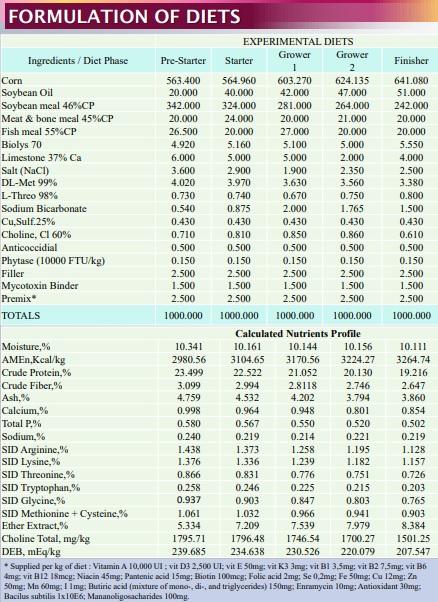Effect of increasing levels of guanidinoacetic acid diet supplementation on broiler performance during hot climate
Published: January 3, 2023
By: Eduardo A.F. Butolo 1,2; José Eduardo Butolo 1; Ricardo J. Sales 2; Leanderson L. Costa 2 / 1 Biojeb Instituto de Biociência – Mogi Mirim – SP - BRAZIL; 2 R&D Granja Regina – Fortaleza - CE - BRAZIL.
Summary
Key words: Guanidino acetic acid, broilers, performance, nutrition, diet.
Hypothesis
Guanidinoacetic acid (GAA) is synthesized in the liver and kidneys from arginine (Arg) and glycine (Gly) and subsequently methylated by S-adenosylmethione to creatine (2). Heat-stressed birds respond to the presence of higher uric acid concentration and changes in electrolyte balance by increasing the usage of osmoprotectants.
These osmolytes are viable endogenous precursors for Gly (3). On the other hand, high supplemental lysine level on modern genetic broiler line may alter the metabolic balance between amino acids, especially the arg:lys ratio (4). The amino acid arginine, as well as other constituents of the protein, is involved in the synthesis of creatine and polyamines, proline, and as a substrate for synthesis of collagen and nitric oxide (NO) and secretion of growth hormones (GH) and insulin-like growth factors (IGF). The purpose of this experiment was to determine the effect of GAA (CreAMINO 96% –Evonik) addition in a commercial broiler diet at increasing levels during hot climate on poultry performance.
Experimental Design
A total of 3000 broiler chicks in a floor pen trial, were distributed in a completely randomized block design with six treatments and ten replicates, with 50 birds each. The birds received a basal diet with corn, soybean meal, meat and bone meal and fish meal, formulated according to the standards of the local poultry industry in the Northeast of Brazil. The inclusion levels of GAA to the basal diet were 0; 0.05%; 0.1%; 0.15%; 0.2% and 0,25%, replacing the filler in the formulation. The birds were fed 250g of Pre-Starter, 650g of Starter, 1100g of Grower-1, 1400g of Grower-2 and around 800g of Finisher diets during the trial.

Materials and Methods
Local information
The trial was carried out at the Granja Regina experimental facilities located at the Dourado Farm, in Horizonte – CE – Brazil, from February 03, 2017 to March 16, 2017, a period in which high temperatures and incidence of rains make the climate hot and humid with a drop in the performance of birds in non-climatized facilities.
Facilities / housing
Conventional concrete made floors pens adjoining a central aisle, provided with netting open sides with curtains, and clay tiles roof. The measurement of the floor pen unit was 1.58m width x 2.61m length x 0.7m high in which were housed 50 birds, totalling 12 birds/square meter in density. Floor pen was littered with wooden shave. Each floor pen had 1 baby feeder and 1 conventional tube feeder from 0 to 7 days and 2 conventional tube feeder from day 8 to 42 days and 1 bell poultry drinker. Feed and water were offered ad libitum. Lighting regime was in accordance with Breeder recommendations. Fans were used to soften the high temperatures.
Animals / Allocation
Approximately 3300 one-day-old Cobb 500 broiler chicks were obtained from the hatchery, individually weighed and selected. The floor pen units were divided in 6 blocks of 10 pens each. Fifty birds (25 male and 25 female) were allocated to each pen unit at trial initiation, totalizing 3000 birds in the experiment. The six treatments were randomly assigned to the pens within each block. Chicks were allocated at random by block and carefully counted to assure the correct numbers of birds placed into each experimental pen. Pen weight was recorded at trial initiation (Day 0).
Experimental procedures
Body weight was recorded for each pen at day 0, 14 and 41 of the experimental period. Feed consumption was recorded for each pen on days 14 and 41, allowing for calculation of body weight gain and feed conversion.
Statistical Analysis
All data were subjected to one-way ANOVA analysis using General Linear Models (GLM) procedures of SAS (5) for each period and for the total period. Comparison of means was performed according to the least square differences (LSD) test. A comparison of the proportion of mortalities in each treatment groups was analyzed as an ANOVA of Arcsine of the square root of the proportion of dead birds. The level of significance adopted was 5%.
Results
At day 14 of the experimental period, increasing levels of GAA in feed positively influenced the performance of the birds with linear response. As seen in table 1 all parameters showed significant difference with linear response to increasing level of GAA. The results of body weight (BW), feed conversion (FC) and feed intake (FI) of birds fed increased levels of GAA until day 41 is showed on table 2. Dietary treatments showed linear increase in body weight (Y=2.4856+0.00482X; R2=0.9535), weight gain and linear reduction on feed conversion (Graph 2). The feed intake was not affected for treatments (P> 0.05). These results are in agreement with those observed by Bryant (1) who added GAA in diets sufficient in Arg and obtained positive results.

Conclusions
The inclusion of increasing levels of guanidinoacetic acid, up to 0.25% in the diet, linearly increases the performance of broiler chickens up to 41 experimental days. There is a possibility that broilers raised under hot and humid climate require higher Gly and Arg fortification and the addition of guanidinoacetic acid can spare arginine and glycine and may yield performance responses.
Presented at the 2018 PSA Annual Meeting, San Antonio, Texas, USA.
1. Bryant-Angeloni KI. Master of science in Animal Science in the Graduate College of the University of Illinois. Urbana-Champaign 2010.
2. Borsook, H., and J.W. Dubnoff. 1940. Creatine formation in liver and kidney. J. Biol. Chem. 134:635-639.
3. E. A. Awad,,I. Zulkifli, A. F. Soleimani, and T. C. Loh. 2015. Individual non-essential amino acids fortification of a low-protein diet for broilers under the hot and humid tropical climate. Poultry Science 94:2772–2777 http://dx.doi.org/10.3382/ps/pev258.
4. J.I.M.Fernandes, A.E.Murakami. 2010. Arginine Metabolism in uricotelic species. DOI: 10.4025/actascianimsci.v32i4.10990.
5. SAS Institute 1999. Versin 8. Cary.
Related topics:
Authors:
Integral Mix
Recommend
Comment
Share
3 de enero de 2023
Have you measured muscle Creatine and urine (droppings) Creatinine level ?
If yes then what is the difference in levels?
Recommend
Reply
3 de enero de 2023
Do you find any reduction / differences in heat stress mortality in different GAA supplement groups?
Recommend
Reply

Would you like to discuss another topic? Create a new post to engage with experts in the community.
Featured users in Poultry Industry

Shivaram Rao
Pilgrim´s
PhD Director Principal de Nutrición y Servicios Técnicos de Pilgrim’s Pride Corporation
United States
United States









